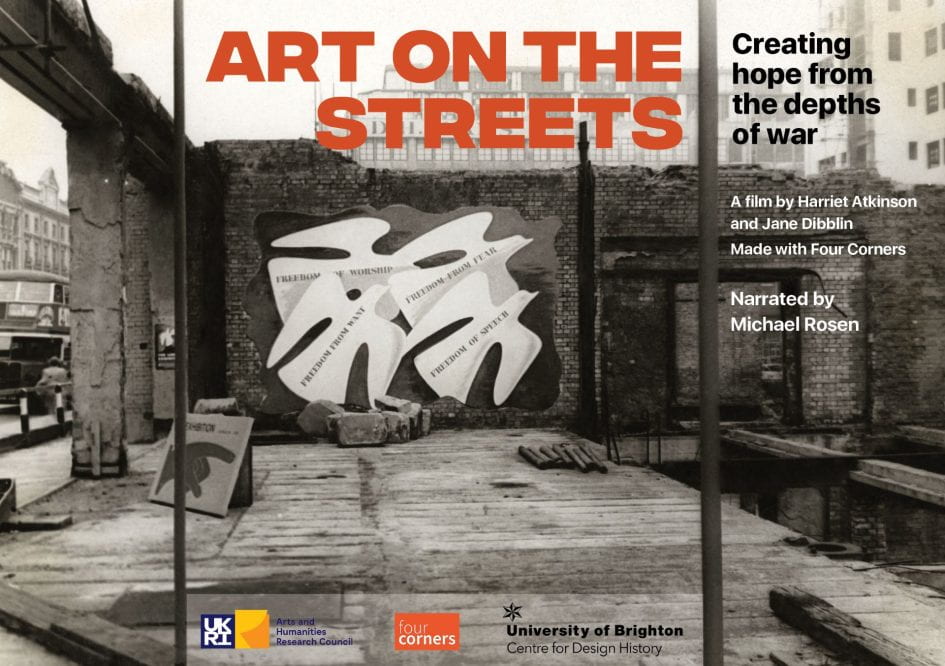Design historian Dr Harriet Atkinson’s research into art on the streets in 1943 is the impetus behind a new Four Corners film narrated by Michael Rosen.
The ‘Art on the Streets’ film
The film explores art’s role in providing a voice, a platform and a meeting point in the midst of conflict, themes which resonate today with audiences all over the word. The 1943 exhibition For Liberty was created by the anti-fascist artists’ collective, Artists International Association, and was an audacious show aiming to demonstrate the values people were fighting for. Central to the exhibition were many artists who had recently arrived in Britain having fled the Nazi threat. The film follows some of those who took part, including Oskar Kokoschka, Peter Laszlo Peri, Betty Rea and designer F. H. K. Henrion. Dr Atkinson said: “Art on the Streets is about creativity in the midst of conflict. It tells the story of an exhibition created on a bombsite to signal a better world after war and shows artists – many displaced from their homes – bringing hope and a clear vision”.
The ‘For Liberty’ exhibition, London, 1943
The exhibition’s central focus were the four freedoms – freedom of worship, freedom of speech, freedom from want and freedom from fear – that would become the key values underpinning the Universal Declaration of Human Rights signed in 1948. They were represented in the exhibition through F. H. K Henrion’s striking design of four doves. The film explores the exhibition’s role as wartime propaganda, the significance of art in the midst of conflict in imagining a peaceful world, questions of how children might fare in the future, and the contribution of refugees to British visual culture. Art on the Streets features interviews with historians Harriet Atkinson, Adrian Shaughnessy, and Gillian Whiteley; and contributing artists’ family members Peter Peri, Will Rea and Max Henrion. It also draws heavily on brilliant archival film and photographs from University of Brighton’s internationally acclaimed Design Archives and Screen Archives South East as well as the Imperial War Museum, Tate, Marx Memorial Library, Mary Evans Picture Library, Henry Moore Institute, Science Museum Group and private collections.
Reactions to the Art on the Streets film
Art on the Streets has already received numerous plaudits from the design history community. Cultural historian Professor Joanna Bourke said: ‘Wow wow wow… So powerful, I had tears in my eyes… A documentary for our times. Aesthetically beautiful, politically gripping, and inspiring. Art has always been a way to depict injustices and imagine better worlds: these artists were all extraordinary’. Design historian Professor Deborah Sugg Ryansaid: ‘A fascinating insight into the work of artists and designers who took art out of the gallery and onto bomb-damaged streets. This film reveals the hitherto overlooked contributions of women artists to the socially engaged art and design of World War Two’. Architecture and Design critic of the The Financial TimesEdwin Heathcote said: ‘This study of the inhabitation of a bombed-out department store by an exhibition concerned with liberty, reconstruction, the elimination of poverty and the defeat of fascism provides a wonderfully optimistic vision of a future that became the post-war Welfare State instituted by radical artists from across Europe. It is a life-affirming view of the capacity of art and design to provide hope in the darkest circumstances.’ View the trailer for Art on the Streets and look out for further information on film screenings.
Who was involved with the Art on the Streets film?
Dr Harriet Atkinson has written extensively on twentieth century design in and from Britain. She is a member of the University of Brighton’s Centre for Design History and her project draws on material from the University of Brighton’s internationally significant Design Archives. She has co-created the film during the Arts and Humanities Research Council Leadership Fellowship The Materialisation of Persuasion which investigates how exhibitions mounted from 1933 to 1953 in public spaces, from church halls to train stations, were designed to communicate messages of propaganda and resistance. Jane Dibblin is an award-winning director and producer, journalist and author. Her film Power Play (BBC2) was voted as the best piece on the UN in any media worldwide, winning first prize in the New York UNCA awards. She also co-directed and produced a three-part series for BBC2 The Terror and the Truth, delving into truth, justice and reconciliation in the wake of conflict and oppression, which won the ECHO European international human rights prize. Animator Kate Bilbow is a recent MA Animation graduate from University of the Arts London, having studied for her BA (Hons) in Illustration from University of Brighton. Her work is rooted in an appreciation for traditional media and often explores themes of memory and sense of place. Co-Producer Carla Mitchell is Artistic Director at Four Corners, where she curates the public gallery programme. Recent exhibitions include Photographing Protest: Resistance through a feminist lens (2022), Another Eye: Women Refugee Photographers in Britain after 1933 (2020) and Heartfield: One Man’s War (2020). Are you interested in studying design history in the internationally acclaimed department at the University of Brighton and with the research Centre for Design History? Find out more about studying BA(Hons) Design History at the University of Brighton, or taking a PhD doctorate in Design History or PhD doctorate in Art History at the university.
Screening of Harriet Atkinson’s new film Art on the Streets at Brighton’s Cinecity Festival Thursday 16th November 2023
Art on the Streets is screening at Fabrica Cinema, 40 Duke Street, Brighton as part of Brighton’s Cinecity Film Festival 2023.
It will be shown alongside two other documentaries made by local filmmakers and followed by a Q&A between the filmmakers and Dr Frank Gray.
Tickets are available at Eventbrite here: https://www.eventbrite.co.uk/e/cinecity-open-docs-tickets-739702519147




Leave a Reply